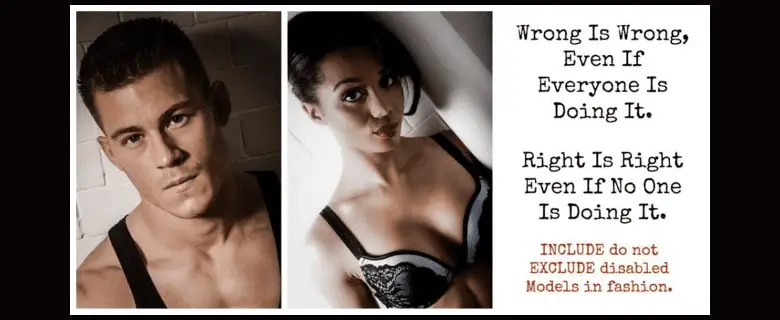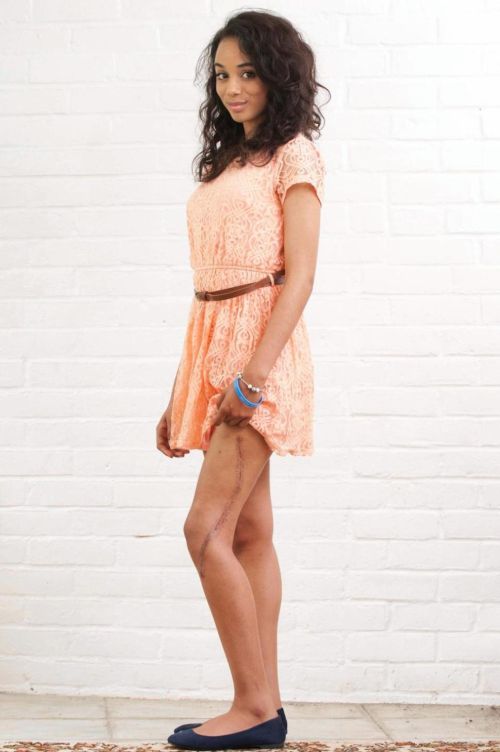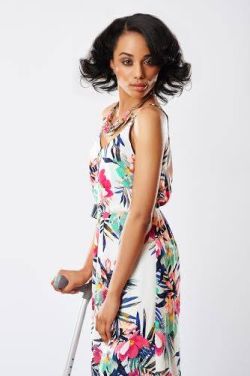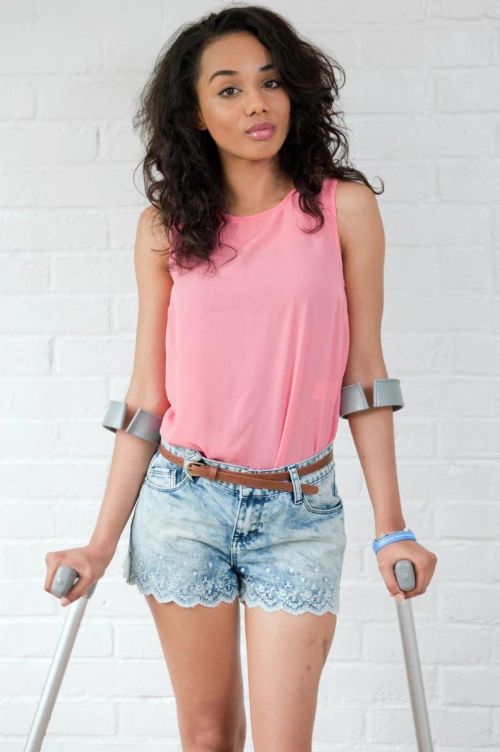
Bionic model: disability won’t stop Elesha Turner
Model Elesha Turner has had her leg amputated and rebuilt after developing bone cancer. But she doesn’t think of herself as being disabled. We spoke to Elesha about her now bionic leg, how she got into modelling, and how she is determined that her disability won’t stop her.
Please can you tell Disability Horizons readers a bit about yourself?
My name is Elesha Turner and I am 21 years old. I have only been labelled as ‘disabled’ for a year after developing bone cancer and needing to have my leg rebuilt. I have been told that in the future I will be rehabilitated and able to walk again, although I will never be as physically able as I used to be – I may have to walk with a stick from time to time, as I do all the time now. But considering the disease that caused me to be in this situation, I am very grateful to be here, to still have my leg and to have a second chance at life.
 Tell us about how bone cancer affected you and how your leg has been repaired.
Tell us about how bone cancer affected you and how your leg has been repaired.
When I was 19 I was diagnosed with a type of bone cancer called Parosteal Osteosarcoma, which is a very rare form of cancer. To hear the words; ‘you have cancer,’ will change the way you view life forever. I personally went through stages – anger, upset, hurt. I also went through a stage of feeling grateful, I was grateful that this had not happened to my loved ones.
After I got my official diagnoses I had to go through surgery to save my leg, the day before my 20th birthday. I had half of the bones in my leg replaced with titanium – my femur, knee and the top of my tibia – meaning I now have a bionic leg. They also completely removed the two muscles from the side of my leg.
 Although the cancer cells that had developed were high grade, meaning there was more risk of them developing further, they hadn’t spread so the oncologists decided not to give me chemotherapy, but just kept a close eye on me.
Although the cancer cells that had developed were high grade, meaning there was more risk of them developing further, they hadn’t spread so the oncologists decided not to give me chemotherapy, but just kept a close eye on me.
I also had more surgery to replace my prosthetic bone recently in June as it had come lose inside the bone I had left, which was causing me quite a lot of pain.
You landed a job as a disabled model with Models of Diversity, can you tell us a bit about that and how it started?
 When I was recovering at home I read an article my auntie had suggested reading. It was about disabled models and Models of Diversity. After reading in – and with persuasion from my mum – I made the decision to contact them and take one of the body confidence workshops they were running. At the workshop the CEO of the company, Angel Sinclair, was interested in me auditioning as a model.
When I was recovering at home I read an article my auntie had suggested reading. It was about disabled models and Models of Diversity. After reading in – and with persuasion from my mum – I made the decision to contact them and take one of the body confidence workshops they were running. At the workshop the CEO of the company, Angel Sinclair, was interested in me auditioning as a model.
I am now one of the models included in the Models of Diversity campaign calling for more inclusion of disabled people in the fashion and beauty industry.
What do you enjoy most about being a model?
I was never interested in modelling before my diagnoses, but the opportunity presented itself and I took it. I thought; ‘why not, it would be a new experience and in something I felt passionate about.’ It’s important that we get more inclusion of diverse people in an industry that clearly discriminates.
I also enjoy challenging people’s perceptions of what they consider beauty to be. The surgery has meant that I look different from the norm – I have muscle loss in my leg and a foot long scar on my left leg. I also have to use aids to help me get around, such as crutches and a wheelchair for long distances. Does that mean that I am not beautiful and I should be excluded from the industry? I think not.
What has been your proudest achievement to date?
I think my proudest achievement has been being able to change what was at the time a negative into a positive. Although I still have a fear of the cancer returning, I try my hardest not to let this consume me and think of all the people still fighting this disease. Thinking about the strength they show gives me courage.
 What are your goals and aspirations for the future?
What are your goals and aspirations for the future?
I would really like to do a degree in the future that includes my interests and can help with the raising awareness of primary bone cancer. I’m also keen to keep up the work with Models of Diversity.
You’re involved in charity work with bone cancer research. Can you tell us what you’re doing at the moment to raise awareness of the condition?
Bone Cancer Research Trust is an incredible charity that funds research and supports people that have been affected by bone cancer in any way. As it is such a rare cancer, it was such a help to be able to meet people that have been affected by the same type of disease. It also made me more determined to raise awareness, because it is such a rare cancer people are not getting diagnosed in time, and this is one of the reasons survival rates have not change in over 25 years. I am using opportunities that are coming up in the papers and media to raise awareness.
I am also putting together a Bone Cancer Research Trust calendar, which will feature people that have had primary bone cancer and their loved ones that have been affected by it. It will be a fun gym themed calendar that will show the strength of people that have been affected by the disease.
If anyone wishes to donate, or support the charity, how can they get involved?
If people wish to support the charity in any way, they can do by going to the website and getting in touch. The website is www.bcrt.org.uk. You can also offer support on to find the perfect job for you. Facebook.
By Zubee
Check out…
• Models of Diversity: could you be the next hot disabled model?
• Q&A with Ashley Thomson: one-handed hairdresser
• New York Fashion Week: the first runway model in a wheelchair
Get in touch by messaging us on Facebook, tweeting us @DHorizons, emailing us at editor@disabilityhorizons.com or leaving your comments below.
Originally posted on 22/09/2014 @ 12:30 am